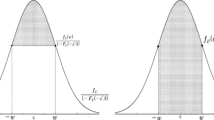Abstract
In statistical analysis, particularly in econometrics, it is usual to consider regression models where the dependent variable is censored (limited). In particular, a censoring scheme to the left of zero is considered here. In this article, an extension of the classical normal censored model is developed by considering independent disturbances with identical Student-t distribution. In the context of maximum likelihood estimation, an expression for the expected information matrix is provided, and an efficient EM-type algorithm for the estimation of the model parameters is developed. In order to know what type of variables affect the income of housewives, the results and methods are applied to a real data set. A brief review on the normal censored regression model or Tobit model is also presented.
Similar content being viewed by others
References
Amemiya T (1973) Regression analysis when the dependent variable is truncated normal. Econometrica 41: 997–1016
Amemiya T (1984) Tobit models: a survey. Econometrica 24: 2–61
Andrews D, Mallows C (1974) Scale mixtures of normal distributions. J R Stat Soc Ser B 36: 99–102
Arellano-Valle R, Branco M, Genton M (2006) A unified view on skewed distributions arising from selections. Can J Stat 34: 581–601
Arellano-Valle R, Genton M (2008) On the exact distribution of the maximum of absolutely continuous dependent random variables. Stat Probab Lett 78: 27–35
Arellano-Valle R, del Pino G, San Martín E (2002) Definition and probabilistic properties of skew-disstributions. Stat Prob Lett 58: 111–121
Barros M, Galea M, González M, Leiva V (2010) Influence diagnostics in the Tobit censored response model. Stat Methods Appl 19: 379–397
Blundell R, Meghir C (1987) Bivariate alternatives to the Tobit model. J Econ 34: 179–200
DaVanzo J, Lee D (1978) The compatibility of child care with labor force participation and non-market activities. Rand Corporation, Santa Monica
Dempster A, Laird N, Rubin D (1977) Maximum likelihood for incomplete data via the EM algorithm. J R Stat Soc Ser B 39: 1–22
He X, Cui H, Simpson D (2004) Longitudinal data analysis using t-type regression. J Stat Plan Inf 122: 253–269
He X, Simpson D, Wang G (2000) Breakdown points of t-type regression estimators. Biometrika 87: 675–687
Hutton J, Stanghellini E (2011) Modelling bounded health scores with censored skew-normal distributions. Stat Med 30(4): 368–376
Johnson N, Kotz S, Balakrishnan N (1994) Continuous univariate distributions, Vol 1. Wiley, Amsterdam
Lange K, Little R, Taylor J (1989) Robust statistical modeling using the t distribution. J Am Stat Assoc 84: 881–896
Lin T, Lee J, Ni H (2004) Bayesian analysis of mixture modelling using the multivariate t distribution. Stat Comput 14: 119–130
Liu C, Rubin D (1995) ML estimation of the t distribution using EM and its extensions, ECM and ECME. Stat Sin 5: 19–39
Maddala G (1983) Limited-dependent and qualitative variables in econometrics. Econometric Society Monographs in Quantitative Econometrics. Econometric Society Publication No. 3. Cambridge University Press
Meng X, Rubin D (1993) Maximum likelihood estimation via the ECM algorithm: a general framework. Biometrika 80: 267–278
Mroz T (1987) The sensitivity of an empirical model of married women’s hours of work to economic and statistical assumptions. Econometrica 55: 765–799
Olsen R (1978) Note on the uniqueness of the maximum likelihood estimator for the Tobit model. Econometrica 46: 1211–1215
Powell J (1994) Estimation of semiparametric models. In: Heckman J, Leamer E, (eds) Handboook of econometrics. Elsevier, Amsterdam 6B, pp 5307–5368
Therneau T, Grambsch P, Fleming T (1990) Martingale-based residuals for survival models. Biometrika 77: 147–160
Tobin J (1958) Estimation of relationships for limited dependent variables. Econometrica 26: 24–36
Venables W, Ripley D (2000) S Programming. Springer, New York
Wilks S (1932) Certain generalizations in the analysis of variance. Biometrika 24: 471–494
Author information
Authors and Affiliations
Corresponding author
Rights and permissions
About this article
Cite this article
Arellano-Valle, R.B., Castro, L.M., González-Farías, G. et al. Student-t censored regression model: properties and inference. Stat Methods Appl 21, 453–473 (2012). https://doi.org/10.1007/s10260-012-0199-y
Accepted:
Published:
Issue Date:
DOI: https://doi.org/10.1007/s10260-012-0199-y



